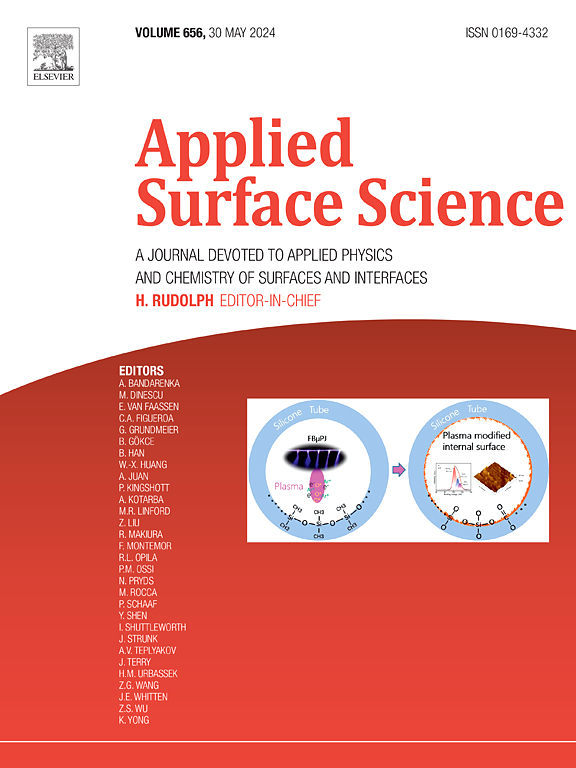The surface modification of NiO@NiSe2 enhanced high energy storage properties for flexible hybrid supercapacitor
IF 6.3
2区 材料科学
Q2 CHEMISTRY, PHYSICAL
引用次数: 0
Abstract
Self-standing composite nanostructures have attracted significant attention in energy storage devices to enhance capacity for practical applications, such as supercapacitors. In this regard, we propose a simple and efficient electrodeposition technique to fabricate a surface-modified NiO@NiSe2 cathode for a hybrid supercapacitor (HSC) via a chronoamperometry-based process. The composite NiO@NiSe2 structure exhibits a high areal capacity (307.2 µAh cm−2) compared with NiSe2 (213.3 µAh cm−2) and NiO (60.1 µAh cm−2) electrode materials. The enhanced performance is attributed to the smoothing effect produced by oxygen vacancies in NiO within the layered NiSe2 nanostructure, which shortens the ion migration path, while the open structure of layered pores and nanoflakes accelerates ion transport. Furthermore, the composite NiO@NiSe2 has been used to construct a full-cell device to demonstrate practical applicability, with activated carbon as the negative electrode material. The fabricated device, NiO@NiSe2//AC, delivers a notable areal capacitance, energy, and power density (301.4 mF cm−2; 94.2 µWh cm−2; and 1000 µW cm−2, respectively) at a current density of 3 mA cm−2. Additionally, the device exhibits long-term cycling performance, maintaining 81.3 % capacity retention after approximately 4500 cycles at a practical high current density of 35 mA cm−2. Moreover, the HSC device was successfully evaluated by powering multiple LEDs, demonstrating its practical applicability. TOF-SIMS, XPS, Raman, FE-SEM, and FE-TEM analyses were conducted to elucidate the structural evolution and electrochemical reaction mechanisms of the NiO@NiSe2 composite structure. These results suggest that the composite structure design, including the use of activated carbon in hybrid supercapacitors, is promising for developing energy storage devices for wearable and electronic applications.

NiO@NiSe2的表面改性提高了柔性混合超级电容器的高能量存储性能
自给式复合纳米结构在储能器件中具有重要的应用价值,如超级电容器。在这方面,我们提出了一种简单有效的电沉积技术,通过基于时间电流的工艺为混合超级电容器(HSC)制造表面改性NiO@NiSe2阴极。与NiSe2(213.3 µAh cm−2)和NiO(60.1 µAh cm−2)电极材料相比,复合NiO@NiSe2结构具有更高的面容量(307.2 µAh cm−2)。层状nis2纳米结构中NiO中的氧空位产生平滑效应,缩短了离子迁移路径,而层状孔隙和纳米薄片的开放结构加速了离子迁移。此外,复合材料NiO@NiSe2已被用于构建全电池装置,以活性炭作为负极材料,以证明实用性。制造的器件NiO@NiSe2//AC提供了显着的面电容,能量和功率密度(301.4 mF cm−2; 94.2µWh 厘米−2;和1000 µW cm−2),电流密度为3 mA cm−2。此外,该器件具有长期循环性能,在35 mA cm−2的实际高电流密度下,在大约4500次循环后保持81.3 %的容量保留率。此外,通过为多个led供电成功评估了HSC器件,证明了其实际适用性。通过TOF-SIMS、XPS、Raman、FE-SEM和FE-TEM分析,阐明了NiO@NiSe2复合结构的结构演化和电化学反应机理。这些结果表明,复合结构设计,包括在混合超级电容器中使用活性炭,有望开发可穿戴和电子应用的储能设备。
本文章由计算机程序翻译,如有差异,请以英文原文为准。
求助全文
约1分钟内获得全文
求助全文
来源期刊

Applied Surface Science
工程技术-材料科学:膜
CiteScore
12.50
自引率
7.50%
发文量
3393
审稿时长
67 days
期刊介绍:
Applied Surface Science covers topics contributing to a better understanding of surfaces, interfaces, nanostructures and their applications. The journal is concerned with scientific research on the atomic and molecular level of material properties determined with specific surface analytical techniques and/or computational methods, as well as the processing of such structures.
 求助内容:
求助内容: 应助结果提醒方式:
应助结果提醒方式:


